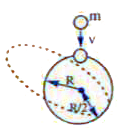Three particles of identical masses .m. are kept at the vertices of an equilateral triangle of each side length.a.. Find the gravitational force of attraction on any one of the particles.Solution in Telugu
√Gm3a2
√3Gma3
√3Gm23a3
√Gm2a3
The correct Answer is:B
Step by step video, text & image solution for Three particles of identical masses .m. are kept at the vertices of an equilateral triangle of each side length.a.. Find the gravitational force of attraction on any one of the particles. by Physics experts to help you in doubts & scoring excellent marks in Class 11 exams.
Topper's Solved these Questions
- BOOK - AAKASH SERIESCHAPTER - GRAVITATIONEXERCISE - LECTURE SHEET (EXERCISE -I) Kepler.s Laws and Newton.s Law of Gravitation (Linked Comprehension Type Questions)3videos
GRAVITATION
- BOOK - AAKASH SERIESCHAPTER - GRAVITATIONEXERCISE - LECTURE SHEET (EXERCISE -I) Kepler.s Laws and Newton.s Law of Gravitation (Matrix Matching Type Questions)1videos
GRAVITATION
- BOOK - AAKASH SERIESCHAPTER - GRAVITATIONEXERCISE - QUESTIONS FOR DESCRIPTIVE ANSWERS2videos
GRAVITATION
- BOOK - AAKASH SERIESCHAPTER - GAUSS.S LAW EXERCISE - PROBLEMS (LEVEL - II)12videos
GAUSS.S LAW
- BOOK - AAKASH SERIESCHAPTER - GRAVITATIONALEXERCISE - EXERCISE -3154videos
GRAVITATIONAL
Similar Questions
A binary star system consists of two stars of masses m and 2 m. The separation between the centres is L. They revolve about the centre of mass of the system under their mutual gravitational interaction force.
Heavier star revolves in an orbit of radius09:00View SolutionMatch the following columns for a planet of mass m revolving around the sun is an elliptical oribt of semi-major axis a and semi-minor axis b. T is time period of planet.
Column-IColumn-II(A)T2∝a3(P) Kepler.s first law(B) Areal velocity is constant(Q) Kepler.s second law(C) Orbit of planet is elliptical(R) Kepler.s third law(D)2πmabT=constant(S)none of the above04:18View SolutionA wreckage of mass m present in space collides with a satellite of mass 10m and orbital radius R as shown. As a result of collision, the wreckage sticks to the satellite and the satellite is transferred to an orbit whose minimum distance from the planet is R/2. If mass of planet is M, with what velocity the wreckage collided the satellite?
 05:45View Solution
05:45View SolutionA charge q is placed at the centre of the open end of a cyclindrical vessel. Find the flux of the electric through the surface of the vessel.
01:24View SolutionA satellite takes 1/8 years to move round the earth in its permissible orbit of radius R. The period when it revolves round the earth in an orbit of radius '2R' is
01:54View SolutionThree particles each of mass m are kept at the vertices of an euilateral triangle of side L . The gravitational field at the centre due to these particle is
05:10View SolutionThree particles each of mass m are palced at the corners of an equilateral triangle of side b. The gravitational potential energy of the system of particle is
09:00View SolutionThree identical particles each of mass m are placed at the vertices of an equilateral triangle of side a. Fing the force exerted by this system on a particle P of mass m placed at the (a) the mid point of a side (b) centre of the triangle
04:13View SolutionThree particles each of mass m are kept at vertices of an equilateral triangle of side L. The gravitational field at centre due to these particle is
View SolutionThe gravitational potential energy of a system of three particles of mass m each kept at the vertices of equilateral triangle of side x will be
View SolutionThree particles each of mass m are placed at the three corners of an equilateral triangle of side L. A particle of mass M is kept at the midpoint of any one side. What is the force acting on M, due to this system of 3 particles ?
04:26View SolutionThree particles each of mass m are kept at the vertices of an euilateral triangle of side L. The gravitational field at the centre due to these particle is
View SolutionThree particles, each of mass m are fixed at the vertices of an equilateral triangle of side length a . The only forces acting on the particles are their mutual gravitational forces. Then answer the following questions. Force acting on particle C , due to particle A and B
View SolutionThree particles of the same mass are kept at the vertices of an equilateral triangle. The mass of each particle is m and the length of an arm of the triangle is l. Due to the the mutual gravitational force of attraction, the particles revolve along the circumcircle of the triangle. Find the velocity of each particle.
View SolutionAt the vertices of an equilateral triangle of side a, three particles each of mass m are kept. Find the gravitational potential and the gravitational field at the centroid of the triangle.
View SolutionThree particles of identical masses .m. are kept at the vertices of an equilateral triangle of each side length.a.. Find the gravitational force of attraction on any one of the particles.
01:12View Solution
